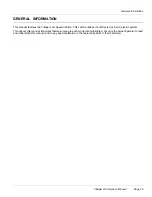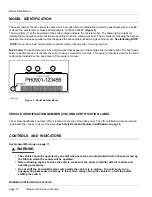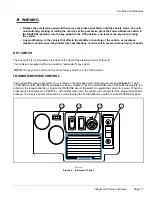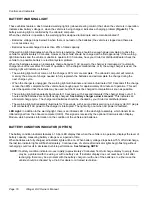
Driving Instructions
pedal goes more than halfway to the floor, or if the vehicle swerves or fails to stop, have the brake system checked
and adjusted as required. Brake adjustment must be maintained so that the brake pedal cannot be pressed to the
floor under any circumstance.
•
Park brake:
When latched, the park brake should lock the wheels and hold the vehicle stationary (on an incline of
20% or less). It should release when pressure is applied to the brake pedal.
•
Reverse buzzer:
The reverse buzzer should sound as a warning when the Forward/Reverse switch is in the
REVERSE position.
•
Steering:
The vehicle should be easy to steer and should not have any play in the steering wheel.
•
General:
Listen for any unusual noises such as squeaks or rattles. Check the vehicle ride and performance. Have
a Club Car distributor/dealer or a trained technician investigate anything unusual.
•
Accelerator:
With the key switch in the ON position and the Forward/Reverse switch in the FORWARD position, as
the accelerator pedal is pressed, the motor should start and the vehicle should accelerate smoothly to full speed.
Club Car vehicles operate at reduced speed in reverse. When the pedal is released, it should return to the original
position and the motor should go into motor braking mode.
See Motor Braking below.
•
Walk-Away Braking:
With the vehicle parked on level ground and the park brake disengaged, place the Tow/Run
switch in the RUN position and attempt to push the vehicle. Motor braking should engage and cause resistance to
rolling (moving at no more than 1 to 3 mph) (1.5 to 4.8 km/h) with the Forward/Reverse switch in any position.
When walk-away braking is engaged, the reverse buzzer should emit a distinct pattern of beeps.
See following
WARNING.
WARNING
• Walk-away braking will not limit vehicle speed to 1 mph (1.6 km/h) on steep grades. Do not operate
vehicle on slopes exceeding 20% grades.
•
Motor Braking:
Accelerate down an incline with the accelerator pedal fully pressed. When the vehicle reaches
maximum programmed speed, motor braking should engage and limit the vehicle to its maximum programmed
speed. On very steep grades, the vehicle may slightly exceed its maximum programmed speed, requiring the
use of the brake pedal. Also, travel downhill with the accelerator pedal partially pressed. Motor braking should
limit speed to less than top speed and maintain speeds proportional to the accelerator pedal position. On a
level surface, accelerate the vehicle to full speed and then release the accelerator pedal. Motor braking should
smoothly slow the vehicle to a complete stop.
DRIVING INSTRUCTIONS
WARNING
• The driver must possess a valid, unrestricted driver’s license issued by the State in which the vehicle
will be operated.
• Before allowing anyone to drive the vehicle, make sure the driver is familiar with all controls and
operating procedures.
• No more than four people should be on the vehicle at one time.
• The driver and passengers must be restrained at all times with seat belts to help prevent injury in the
event of sudden braking or collision.
• Do not allow people to ride in any part of the vehicle that is not equipped with a seat and a seat belt.
Do not allow a third person to sit in the middle of the seat or allow a passenger to hold a child in his or
her lap while the vehicle is moving.
• The vehicle is not specially equipped for handicapped persons:
WARNING CONTINUED ON NEXT PAGE
Page 26
Villager LSV Owner’s Manual
















































